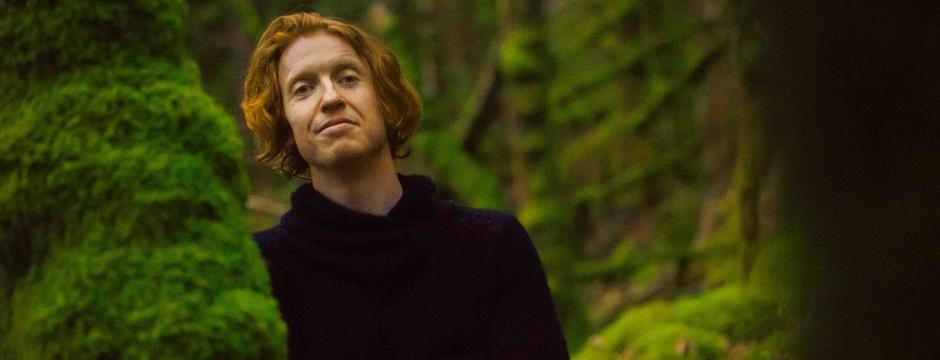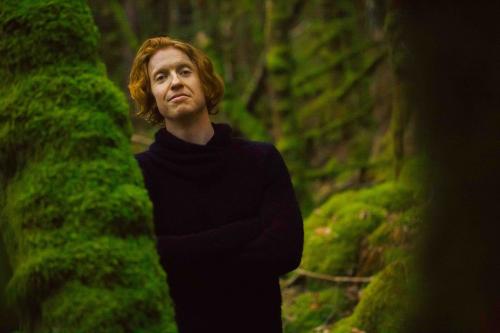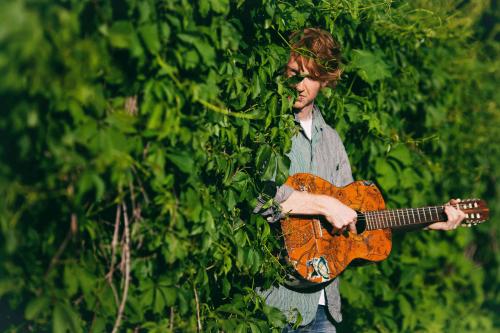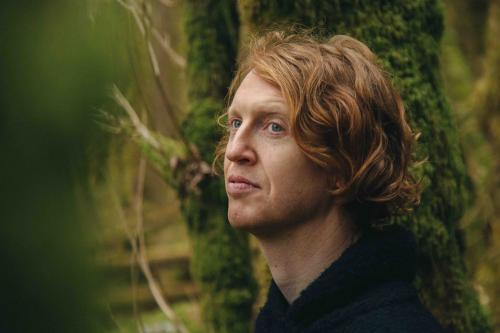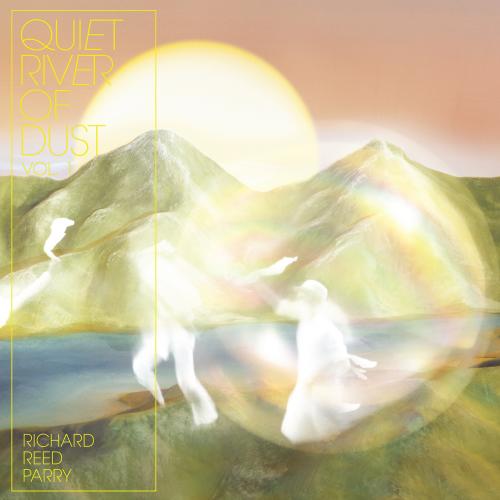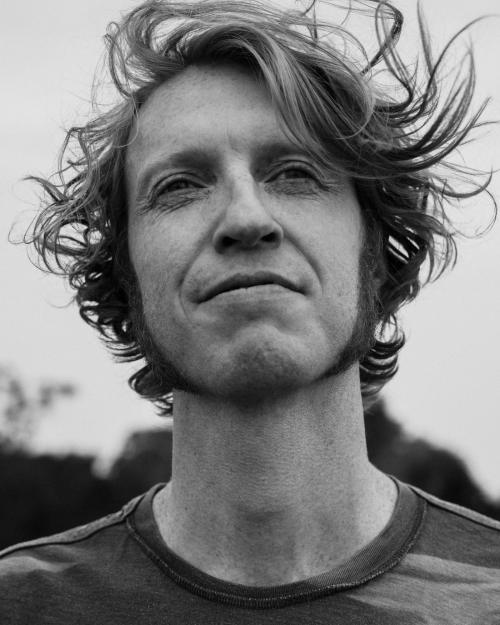Band: Richard Reed Parry
Album: Quiet River of Dust Vol.2
VÖ: 21.06.2019
Label: Anti- Records / Indigo
Website: www.richardreedparry.com
Music of the spheres: it’s a term that refers to the universal harmony generated by celestial bodies in orbit, but it means something different to Arcade Fire’s Richard Reed Parry. His musical spheres are floating worlds, 360° embodiments of memory, VR renditions of old family photos. These spheres not only served as metaphorical inspiration for the lyrics of his new project, Quiet River of Dust, but appear throughout the album artwork and, most strikingly, in the films Parry made to be projected in planetarium-style domes to accompany live performances of this music. “It was an idea of a floating world of memory and of a time that only exists insofar as you’re able to revisit it in your memory,” he explains. “But when you do, it becomes so all-encompassing and immersive that it’s like you’re stepping into this other world every time.” That’s as true of his music as it is of any of its visual representations.
The first volume of Quiet River of Dust was released on the autumn equinox of 2018; this second volume, out on the summer solstice of 2019, was created at the same time. (It was supposed to come out on the spring equinox, but got bumped because Parry and designer Tracey Maurice had to wait for salt crystals to grow on the artwork to create wave caps and mountaintops—do not underestimate Parry’s attention to detail.) Both volumes bleed into one another, by design. “It feels like a multi-sided window to me,” says Parry, “a different view into this prismatic song world.” Japanese folk myths, death poems and British folk music are tributaries flowing into a river of late-20th century avant-garde composition and traditional song craft, written and performed by a member of a Grammy-winning rock band. This is a meditative, widescreen musical experience with Beach Boy harmonies and a hypnotic pulse. Layered songs that move in a linear fashion, following a current rather than circular composition.
The genesis of these songs came after Arcade Fire’s first tour of Japan in February 2008. Parry stayed on for weeks after the last show, heading to a monastery for some solace in “the biggest silence you’ve ever heard.” One day he was walking alone in a massive, snow-covered cedar forest when he heard distant voices, voices that sounded a lot like his father’s folk group back in Toronto, Friends of Fiddlers Green. (Parry was 17 when his father died in 1995.) “There was no reason for something to sound like full-throated, British-Isle folk singing there,” he recalls. “I walked and walked but I could never get closer to where the music was coming from.” He started writing meditative songs about mortality. On a later trip to Japan, he discovered the “River of Death,” a body of water understood in pre-Buddhist Japanese culture to be a liminal space between life and an afterlife.
The two halves of Quiet River of Dust are meant to represent each side of that river. Vol. 2: That Side of the River is more interior, says Parry, dealing with the murky waters of memory and the unconscious mind. The elegiac opener is a soft fanfare featuring his father’s former bandmates. That bleeds into “Lost in the Waves,” a story about a boy who goes to the ocean with his parents; they fall asleep on the beach, he walks into the ocean “and transforms in some magical, nebulous way,” says Parry. “What separates us from dissolving into the experience around us? It’s a feeling I’ve definitely had many times, where the boundaries of self and world are permeable to the point of disorientation. So much of this record is about being this young person in an older people’s world of music and song, this folk music community where the torch is passed, and losing my father at a young age, and being completely disoriented by that. This record, the songs are also referencing that nebulous psychic territory when you lose your most familiar world, when the village of your childhood disappears and you try to relocate yourself in a different one.”
The music owes debts to that of his father, but Parry didn’t want to write in a traditional British Isles folk style. Nor did he want to create the kind of pop songs to which tens of thousands of people could sing along, as he does with Arcade Fire. That band’s landmark 2004 debut, Funeral, made a grandiose statement through big, bold gestures; Quiet River of Dust does the same, with vertical layers of sonic architecture, but with the inverse approach: small, soft and gentle, though just as grand. Parry wanted to create a tangible aural garden of rapturous colours that invite exploration, an immersive experience. To do so, Parry invited precious few people into his solo project, including Laurel Sprengelmeyer of Little Scream, Stef Schneider of Bell Orchestre, Dallas Good of the Sadies, Yuka Honda of Cibo Matto, Amedeo Pace from Blonde Redhead, mixer Tchad Blake, composer Nico Muhly and The National’s Aaron and Bryce Dessner, who first urged Parry to perform this music live in 2012 at an All Tomorrow’s Parties in the U.K.
When it came time to present Vol. 1: This Side of the River live, he booked two weeks worth of shows at the SATosphere in Montreal in November 2018, and set out assembling video footage that could be projected in the dome. They gave him a tiny 360° camera that he could immerse in water, place inside tree stumps, “all the immersive, tiny spaces that you wouldn’t be able to see inside, looking out,” he says. “It was so beautiful. It made my brain explode with possibilities. When I was a kid I’d get completely enraptured by a melting pool of ice water in the spring, and part of me wished I could be inside of that strange little world. Experimenting with this camera brought me to that kind of place. Bringing it into the dome, you can actually make that image this big, 20-foot, immersive world around you. It’s a zen, contemplative way to be inside nature. Filming all this stuff has become one of my greatest artistic joys, one of the most exciting things I’ve ever done. It’s a unique format to play music in, to step outside the codified world of rock shows in a way that really suits me. This is where this music wants to live.”
That’s where it will live in the next two years: the immersive Quiet River of Dust experience will be returning to Montreal this summer, before travelling to domes in Hamburg, Vancouver, France, South America and Japan. “I’m very curious about who this music is going to find,” says Parry.
Maybe even those ghosts in the Japanese forest will hear the result of the journey they inspired.
Infos zur vorherigen VÖ:
Band: Richard Reed Parry
Album: Quiet River of Dust Vol.1
VÖ: 21.09.2018
Label: Anti- Records / Indigo
Website: www.richardreedparry.com
A man travelling in a foreign land wanders through a forest of ghosts, who sing his past back to him. A rainstorm that starts and never ends. A boy dissolves into a body of water. These images inspire music that tells the story of two spheres: in one, an embodied experience of the physical world; in the other, something disembodied, dissolved and oceanic. Japanese folk myths, death poems and British folk music are tributaries flowing into a river of late-20th century avant-garde composition and traditional song craft, written and performed by a member of a Grammy-winning rock band. This is a meditative, widescreen musical experience with Beach Boy harmonies and a hypnotic pulse. Layered songs that move in a linear fashion, following a current rather than circular composition. This is Richard Reed Parry’s Quiet River of Dust. Being released as two volumes, Quiet River of Dust Vol. 1 will be available on the start of the autumn equinox, September 21 2018. Quiet River of Dust Vol. 2 is coming out next year on the spring equinox 2019.
Long before he joined Montreal’s Arcade Fire in 2003, Parry grew up in a thriving folk music community in Toronto, where house parties were full of singing, where weekly gatherings featured dances of the British Isles, where all the progeny were routinely corralled into singing on popular children’s albums. While a student of electroacoustic music and contemporary dance in university, he formed the instrumental ensemble Bell Orchestre, who have released three albums, with another expected soon. In 2014, he released an album of biologically inspired compositions, Music for Heart and Breath, on the prestigious Deutsche Grammophon classical label.
Quiet River of Dust has been slowly gestating for the last decade, in many ways a necessary respite from Parry’s other gigs. Creating this music grew into a meditative practice. “I’m lousy at sitting still and being nothing,” he says. “But being out in the natural world or being immersed in music is the meditation for me. That’s the heart of this record: the experience of transcending the place that you’re in, getting lost in the feeling of where you end and where the world begins, in a dreamlike world of music and thought.” It is music meant to be absorbed in a setting devoid of other distractions, not shuffled into your streaming playlist—a tall demand these days but one worth the time.
The genesis of these songs came after Arcade Fire’s first tour of Japan in February 2008. Parry stayed on for weeks after the last show, heading to a monastery for some solace in “the biggest silence you’ve ever heard.” One day he was walking alone in a massive, snow-covered cedar forest when he heard distant voices, voices that sounded a lot like his father’s folk group back in Toronto, Friends of Fiddlers Green. (Parry was 18 when his father died in 1995.) “There was no reason for something to sound like full-throated, British-Isle folk singing there,” he recalls. “I walked and walked but I could never get closer to where the music was coming from.” The ghostly experience inspired the song “On the Ground,” which in turn inspired the rest of the song cycle. When it came time to record “On the Ground,” he enlisted his father’s former colleagues on concertina, Northumbrian pipes and fiddle.
More material began to flow, including one song on Vol. 1 called “River of Death” and another about a small boy who disappears into the ocean while his parents are sleeping on the beach. On a return trip to Japan years later, Parry was on a hike by a hot-spring river when he saw a sign directing travelers to a “River of Death” (“Sai No Kawara”). He learned that it was a pre-Buddhist mythological concept of a place where parents go to mourn dead children, a body of water understood to be a liminal space between life and an afterlife.
The two halves of Quiet River of Dust are meant to represent each side of that river. There is a thematic and sonic consistency throughout: the sensation of standing in that river, of “having an ecstatic experience in nature,” says Parry, “when you transcend your physical form and you just don’t know what you are or where you belong.” Hence the song, “I Was in the World, Was the World in Me?” Both volumes of Quiet River of Dust bleed into one another, by design. “It feels like a multi-sided die to me,” says Parry. “It’s all the same song, just a different prismatic view into this song world.”
The music owes debts to that of his father, but Parry didn’t want to write in a traditional British Isles folk style. Nor did he want to create the kind of pop songs to which tens of thousands of people could sing along, as he does with Arcade Fire. That band’s landmark 2004 debut, Funeral, made a grandiose statement through big, bold gestures; Quiet River of Dust does the same, with vertical layers of sonic architecture, but with the inverse approach: small, soft and gentle, though just as grand. Parry wanted to create a tangible aural garden of rapturous colours that invite exploration, an immersive experience.
Three touchstones while recording were the work of avant-garde cellist and songwriter Arthur Russell, the Orb’s Live ’93 album, and Tom Waits’s Bone Machine—the latter mixed by Tchad Blake, who welcomed Parry’s invitation to mix parts of this record. Other guests include Parry’s partner Laurel Sprengelmeyer of Little Scream, Stef Schneider of Bell Orchestre, Dallas Good of the Sadies, Yuka Honda of Cibo Matto, Amedeo Pace from Blonde Redhead, and The National’s Aaron and Bryce Dessner, who first urged Parry to perform this music live in 2012 at an All Tomorrow’s Parties in the U.K. For a musician raised in a musical family and environment, collaboration and community are essential parts of the process.
Parry will launch Vol. 1 in Montreal with a residency in a planetarium-like dome in Montreal, the Satosphere, with half-animated films creating a “floating world” around the performers and audience, he says. After that, “I want to play interesting places where it feels there is space for this. I feel not like taking it to loud places, but to quiet places. I’m very curious about who this music is going to find.”
Maybe even those ghosts in the Japanese forest will hear the result of the journey they inspired.
Bio by Michael Barclay, the author of ‘The Never-Ending Present: The Story of Gord Downie and the Tragically Hip’.
